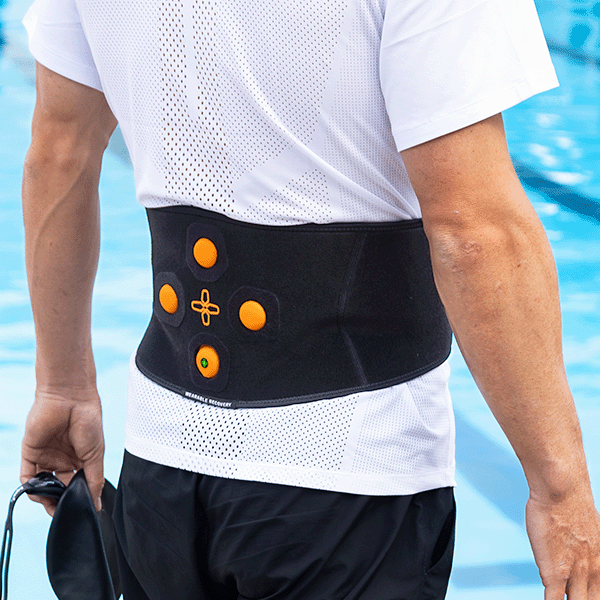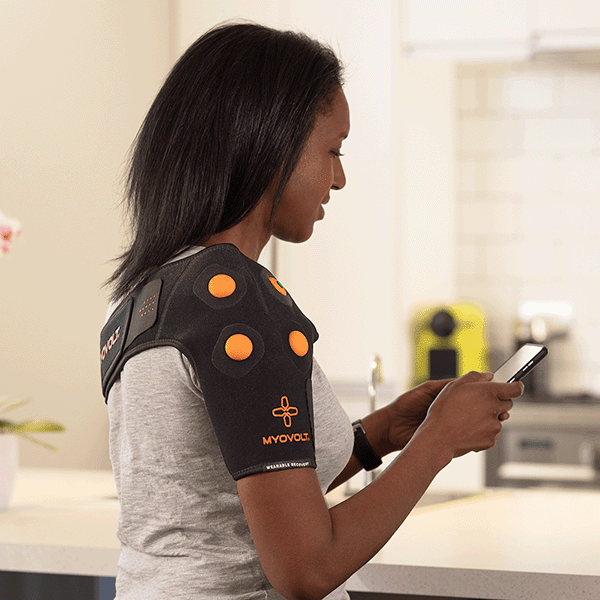Get leg-fit for cycling.
Post-cycle recovery tips to keep you pedalling harder.
Le Race 2021, Christchurch, NZ
Whether you cycle competitively or just bike at the weekends for pleasure, the sport can have an impact on your leg muscles and knees. Although cycling is generally low impact, leg and knee pain is not uncommon particularly if you are taking on hill climbs or intense racing.
Taking adequate steps to recover after cycling is the best way to prevent any injuries occurring. With this in mind we have put together a list of tips to keep your legs in peak condition and ready for your next ride.
The Myovolt team were recently on recently on hand with a recovery station at the finish line of New Zealand's oldest road cycle race. Le Race, dating back to the 1930's is a 100km race from Christchurch to Akaroa including a vertical ascent to approximately 2000m. After being cancelled in 2020, this year's event attracted more than 700 riders from around the country and saw the course record broken with a time of 2 hours 30 minutes.
Top recovery tips for better muscle recovery after long distance cycling.
Take time to cool down.
After your bike race or cycle workout ends, complete a cool down routine. During intense pedaling, the blood vessels in your legs expand to increase the supply of blood and oxygen. Once you are finished, don’t get off your bike just yet. Allow your legs to get used to a lower pedaling intensity so that your blood vessels can return to normal and equalise blood flow to the rest of your body.
If you don’t spend time to cool down, you run the risk of becoming light-headed. Slow pedaling following intense cycling also aids in the removal of lactic acid, to avoid delayed onset muscle soreness.
After your cool down, don’t sit down immediately. Your legs may be tired, but now is not the time to be still. Keep in motion and allow your muscles time to return back to their resting state. Being still right after your race increases the likelihood of sore and stiff muscles developing later on. Gentle cycling at a slow pace or walking will help flush out lactic acid and aid in your recovery.
Hydration is key.
Hydrate before, during, and after your ride. Water is the best option for hydration despite what sports drink companies say. Sports drinks are okay, but you should be careful to avoid overly sugary drinks that will put back on those calories you’ve worked off. Use sports drinks as a supplement to your main source of hydration, water, in order to replenish electrolytes which will help you recover.
While you make a slow transition to rest, be sure to increase your water intake but be careful not to over-hydrate, as it is possible. Additionally, increasing your protein intake after a race can hasten repair of existing muscle damage while strengthening them to prevent future damage.
Make time for massage.
People who exercise heavily can have tighter muscles. Heavily exerted muscles can lose their ability to relax and chronically tight muscles are a problem for any athlete looking to achieve their fitness goals. Tight muscles signify a lack of flexibility, which tends to go hand in hand with muscle soreness. In the worst cases, this tightness means athletes are more likely to suffer serious injuries, like muscle pulls and tears.
Regular massage therapy helps promote blood flow to the muscles, while also helping them to relax over time. This reduces pain, and helps the muscles to stay fresh. After your ride, try a massage either with a massage therapist or you can do it yourself. Invest in a foam roller or a massage tool to alleviate tension and relax your muscles. Physically working your muscles after exercise will improve blood flow to transport much-needed oxygen to your muscles.
Don’t just cool down - warm up.
Warming-up prior to physical activity is just as important as cooling down. Getting your muscles primed and at an optimum temperature is critical for peak performance in explosive sports but essential in any sport to avoid injury. Be careful to avoid warm-up exercises that cause fatigue and make your tired before the race. The convenience of technologies like Myovolt enable fast and efficient warm up without causing tiredness in your muscles.
Wearable recovery.
Myovolt wearable recovery products are used by pro-cyclists as a convenient way to start the recovery process post-race. Targeted vibration technology helps improve localised circulation and remove lactic acid faster. The Myovolt Leg product targets all the main stress areas specific to cycling including, quad, knee and calf and is great to wear whilst you're fixing-up your bike after a long hard ride.
Overall, cycling is a great low impact form of exercise whether that be road, mountain or track. If you are working towards an event or race, take care of your recovery and not to over-train your muscles and joints. Understanding your body and responding to it well will help ensure your knees and legs won't let you down on your journey.
Enjoy road cycling? Check out the Grand Tours.
The Grand Tours are three international road cycling events - the most famous of which is the Tour de France. The other two are the Giro d’Italia and Vuelta a Espana which are held in Italy and Spain respectively. The Grand Tours take place as a multi stage race with the aim being to have the lowest overall aggregated time.
Each Grand Tour is a staged event that includes distance stages of approximately 150km, distance days, elevations and hill climbs, individual time trials and team time trials. These Grand Tours take place over a set time - where each day is an event or even two events in one day.
Featured in this story
Great for recovering tired, overworked knees, quad, calf or hamstring muscles. The neoprene leg brace has an adjustable fit ...
Get leg-fit for cycling.
Pedal harder with post-cycling recovery tips.
Le Race 2021. Christchurch, NZ
Whether you cycle competitively or just bike at the weekends for pleasure, the sport can have an impact on your leg muscles and knees. Although cycling is generally low impact, leg and knee pain is not uncommon particularly if you are taking on hill climbs or intense racing.
Taking adequate steps to recover after cycling is the best way to prevent any injuries occurring. With this in mind we have put together a list of tips to keep your legs in peak condition and ready for your next ride.
The Myovolt team were recently on hand with a recovery station at the finish line of New Zealand's oldest road cycle race. Le Race, dating back to the 1930's is a 100km race from Christchurch to Akaroa including a vertical ascent to approximately 2000m. After being cancelled in 2020, this year's event attracted more than 700 riders from around the country and saw the course record broken by elite rider Michael Vink with a time of 2 hours 30 minutes.
Top tips for better muscle recovery after long distance cycling.
Take time to cool down.
After your bike race or cycle workout ends, complete a cool down routine. During intense pedaling, the blood vessels in your legs expand to increase the supply of blood and oxygen. Once you are finished, don’t get off your bike just yet. Allow your legs to get used to a lower pedaling intensity so that your blood vessels can return to normal and equalise blood flow to the rest of your body.
If you don’t spend time to cool down, you run the risk of becoming light-headed. Slow pedaling following intense cycling also aids in the removal of lactic acid, to avoid delayed onset muscle soreness.
After your cool down, don’t sit down immediately. Your legs may be tired, but now is not the time to be still. Keep in motion and allow your muscles time to return back to their resting state. Being still right after your race increases the likelihood of sore and stiff muscles developing later on. Gentle cycling at a slow pace or walking will help flush out lactic acid and aid in your recovery.
Hydration is key.
Hydrate before, during, and after your ride. Water is the best option for hydration despite what sports drink companies say. Sports drinks are okay, but you should be careful to avoid overly sugary drinks that will put back on those calories you’ve worked off. Use sports drinks as a supplement to your main source of hydration, water, in order to replenish electrolytes which will help you recover.
While you make a slow transition to rest, be sure to increase your water intake but be careful not to over-hydrate, as it is possible. Additionally, increasing your protein intake after a race can hasten repair of existing muscle damage while strengthening them to prevent future damage.
Make time for massage.
People who exercise heavily can have tighter muscles. Heavily exerted muscles can lose their ability to relax and chronically tight muscles are a problem for any athlete looking to achieve their fitness goals. Tight muscles signify a lack of flexibility, which tends to go hand in hand with muscle soreness. In the worst cases, this tightness means athletes are more likely to suffer serious injuries, like muscle pulls and tears.
Regular massage therapy helps promote blood flow to the muscles, while also helping them to relax over time. This reduces pain, and helps the muscles to stay fresh. After your ride, try a massage either with a massage therapist or you can do it yourself. Invest in a foam roller or a massage tool to alleviate tension and relax your muscles. Physically working your muscles after exercise will improve blood flow to transport much-needed oxygen to your muscles.
Don’t just cool down - warm up.
Warming-up prior to physical activity is just as important as cooling down. Getting your muscles primed and at an optimum temperature is critical for peak performance in explosive sports but essential in any sport to avoid injury. Be careful to avoid warm-up exercises that cause fatigue and make your tired before the race. The convenience of technologies like Myovolt enable fast and efficient warm up without causing tiredness in your muscles.
Wearable Recovery.
Myovolt wearable recovery products are used by pro-cyclists as a convenient way to start the recovery process post-race. Targeted vibration technology helps improve localised circulation and remove lactic acid faster. The Myovolt Leg product targets all the main stress areas specific to cycling including, quad, knee and calf and is great to wear whilst you're fixing-up your bike after a long hard ride.
Overall, cycling is a great low impact form of exercise whether that be road, mountain or track. If you are working towards an event or race, take care of your recovery and not to over-train your muscles and joints. Understanding your body and responding to it well will help ensure your knees and legs won't let you down on your journey.
Featured in story
Great for recovering tired, overworked knees, quad, calf or hamstring muscles. The neoprene leg brace has an adjustable fit ...



